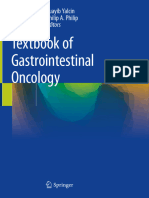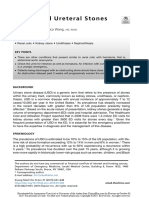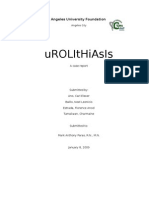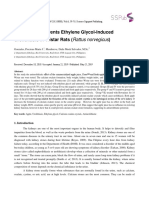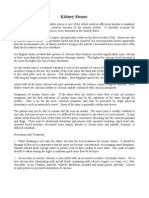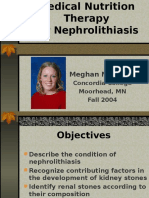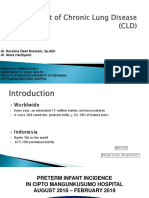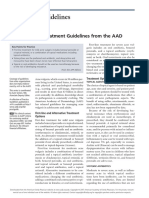Understanding Epidemiology and Etiologic Factors of Urolithiasis: An Overview
Understanding Epidemiology and Etiologic Factors of Urolithiasis: An Overview
Uploaded by
andrilulusanterbaikCopyright:
Available Formats
Understanding Epidemiology and Etiologic Factors of Urolithiasis: An Overview
Understanding Epidemiology and Etiologic Factors of Urolithiasis: An Overview
Uploaded by
andrilulusanterbaikOriginal Description:
Original Title
Copyright
Available Formats
Share this document
Did you find this document useful?
Is this content inappropriate?
Copyright:
Available Formats
Understanding Epidemiology and Etiologic Factors of Urolithiasis: An Overview
Understanding Epidemiology and Etiologic Factors of Urolithiasis: An Overview
Uploaded by
andrilulusanterbaikCopyright:
Available Formats
Science Vision www.sciencevision.org Science Vision www.sciencevision.org Science Vision www.sciencevision.org Science Vision www.sciencevision.
org
www.sciencevision.org
Mini Review
Sci Vis Vol 13 Issue No 4
October-December 2013
ISSN (print) 0975-6175
ISSN (online) 2229-6026
Understanding epidemiology and etiologic factors of
urolithiasis: an overview
Kshetrimayum Birla Singh* and Saitluangpuii Sailo
Department of Zoology, Pachhunga University College, Aizawl 796001, India
Received 16 September 2013 | Revised 21 October 2013 | Accepted 29 October 2013
ABSTRACT
Urolithiasis is a condition in which stones are formed in the urinary tract and considered to be
one of the most common urological disorders, longstanding medical illnesses and common public
health problems. People in many parts of the world including north eastern states of India are
now suffering from the stone diseases. Urinary stone is formed usually due to deposition of calcium, phosphates and oxalates which are a major health hazards. It has been reported that urolithiasis as a multifactorial recurrent disease, distributed worldwide in urban, rural, non-industrial
and industrial regions with different chemical composition of analyzed stones in context to various
risk factors. Besides diet, genetic factors are also reported to contribute in pathogenesis of urolithiasis. Better understanding of the various aspects of this disease including causative agents may
provide an insight of this disorder to the researcher and common people in order to contain this
disease. The epidemiology and various etiologic factors of urolithiasis are highlighted in this communication.
Key words: Urolithiasis; diet; genetic factors; northeast India.
INTRODUCTION
Urolithiasis is a term originated from three
Greek words, ouron for urine, oros for flow,
and lithos for stone. It is the process of forming
stones in the kidney, bladder and/or urethra and
is a complex phenomenon yet not clearly understood. It is considered to be one of the most
common urological disorders and has afflicted
Corresponding author: Singh
Phone: +91-9863385796
E-mail: birla.kshetri@gmail.com
humans since time immemorial. It is a longstanding medical illness and still a common public health.1 A large population of world suffers
from urinary tract and kidney stones, formed
due to deposition of calcium, phosphates and
oxalates. In this process, the chemicals start accumulating over a nucleus, which ultimately
takes the shape of a stone. These stones may be
persisted for indefinite time, leading to secondary complications causing serious consequences to patients life. It is also very painful
and a proper cure is very much needed to get rid
of the problem. Many parts of the world includ-
Science Vision 2013 MAS. All rights reserved
Understanding epidemiology and etiologic factors of urolithiasis: an overview
ing India are now suffering from the stone disease which poses a major health hazard affecting 20% of the general population worldwide. In
the United States alone, up to 12% of men and 6
% of women will develop urolithiasis at some
point in life. In Thailand, the highest prevalence
rate of 16.9 % was reported in the Northeast
provinces, while in Middle Eastern countries,
the lifetime prevalence of kidney stone is even
higher.2,3 As urolithiasis usually recurs with recurrence rates as high as 50 % in 10 years, it
poses difficulty in management and burdensome
medical costs.4
Urolithiasis disease exists in endemic proportions in some parts of country. Areas of high
incidence of urinary calculi include the British
Isles, Scandinavian countries, Northern Australia, Central Europe, Northern India, Pakistan
and Mediterranean countries.5
Renal stones, one of the most painful
urologic disorders, have beset humans for centuries. Each year, worldwide people make almost
3 million visits to health care providers and
more than half a million patients go to emergency room with urolithiasis. Epidemiological
studies indicate many factors like age, sex, industrialization, socioeconomic status, diet and
environment, influences urolithiasis. In urothiolisis, calcareous stone is the most common type
of kidney stone disease and accounts for more
than 80% of all stones. The primary chemical
complexes are calcium oxalate (CaOx) and calcium phosphate (CaP).6 Besides this, urinary
stones contain both crystalloid and colloid components. The crystalloid components are mainly
calcium oxalate, calcium phosphate, calcium
carbonate, magnesium-ammonium phosphate,
uric acid and cysteine. Uric acid (UA) stone
represents about 4.523% and the other less frequent types of kidney stones are magnesium ammonium phosphate (MAP) or struvite stones,
ammonium urate stones, cystine stones, xanthine and other miscellaneous stones.3,7
The literature has reported that urolithiasis
as a multifactorial recurrent disease, distributed
worldwide in urban, rural, non-industrial and
industrial regions with different chemical com-
170
position of analyzed stones in context to various
etiological and risk factors. It includes both intrinsic factors such as demographic (age, gender
and race), anatomic and genetic aspects, and
extrinsic factors such as geographic predilection,
climate, lifestyle pattern as well as dietary habits. During the past few decades, the prevalence
of kidney stones in both males and females has
markedly increased in industrialized countries.6
This is presumably due to changes in lifestyle
and dietary habit of the peope in these regions.
Figure 1. Stones in the kidney and ureter.
INFLUENCE
OF
DIET
ON
UROLITHIASIS
Dietary factors are also considered to play an
important role in kidney stone formation, and
dietary modification can reduce the risk of stone
recurrence. Though only 10% to 20% of urinary
oxalates come from dietary sources, dietary reduction is commonly advised for calcium oxalate stone formers. It has been suggested that
since there is much less oxalate in the urine than
calcium in the urine, urinary oxalate concentration is much more critical to the formation of
calcium oxalate crystals than is the urinary cal-
Science Vision 2013 MAS. All rights reserved
Birla Singh and Sailo
Table 1. Major and subtypes of stones in urolithiasis according to chemical components. 7
Major Type
Subtypes
Calcium oxalate monohydrate (40-60%)
Calcium Stone (70-80%)
Uric Acid Stone (5-10%)
Cystine Stone (1%)
Struvite (1%)
Xanthine Stone (1%)
Calcium oxalate dehydrate (40-60%)
Calcium hydrogen phosphate (brushite) (2-4%)
Calcium orthophosphate (<1%)
Mixed calcium oxalate-phosphate (35-40%)
Mixed uric acid-calcium oxalate (5% )
Mixed Stones (50-60%)
cium concentration; reducing urine oxalates
may have a more powerful effect on stone formation than can reduction of urine calcium. Patients with calcium oxalate stones, particularly
those with documented hyperoxaluria, should
avoid foods high in oxalates.8 Moreover, vitamin
C is a precursor to endogenous production of
oxalates, so some clinicians recommend avoiding mega-doses of vitamin C. The rare genetic
condition of primary hyperoxaluria is only
slightly impacted by dietary reduction, and
causes serious medical problems besides kidney
stones. The effect of excess animal protein
(purine) is also most obvious for the uric acid
stone former. Uric acid, a by-product of purine
metabolism, is excreted in large quantities in the
urine. Excess protein creates urine with high
total urine uric acid, potentially high super saturation of urine uric acid, and a low pH, necessary for formation of uric acid stones. There is
no inhibitor of uric acid crystal formation, so
dietary measures focus on reducing uric acid
and increasing urine volume.9 In regard to this,
reduction of animal protein to 12 ounces per day
for adults is recommended. This is plenty to
meet the dietary needs of most population in
India, many of whom typically consume several
more ounces of animal protein daily than is recommended. Protein from plant sources (beans,
legumes, etc.) can be substituted as a dietary
alternative without negative consequences however calcium oxalate stone formers reducing
their animal protein should also note the oxalate
content of substitute proteins. The role of excess
protein in promoting calcium stone formation is
less obvious, but equally important. High dietary protein is associated with increased urinary
calcium. Thus, there is a link between meat consumption and both uric acid and calcium stone
formation.10 Therefore, the benefits of protein
restriction for stone formers are many. It has
been reported that super saturation of urinary
lithogenic promoters such as calcium, oxalate,
phosphate and uric acid mostly obtained from
the diet are considered as the risk factors of renal
stone formation. On the other hand, a decreased
urinary concentration of stone inhibitors such as
citrate, potassium and magnesium is also a critical risk. The urinary levels of these stone modulators are greatly influenced by diet.
CANDIDATE GENES
FOR
UROLITHIASIS
Genetic factors are known to play a role in
urolithiasis. Studies have tried to identify genes
related to ureter calculi in an effort to clarify the
cause of urolithiasis and to advance the diagnosis and treatment of urolithiasis.11,12 It has been
reported that the use of single-nucleotide polymorphisms (SNPs) associated with genetic diseases has been fruitful in identifying candidate
disease genes. Recent genetic advances in urolithiasis indicate the potential of a new approach
towards the gene polymorphism.9,13-15 Moreover,
Science Vision 2013 MAS. All rights reserved
171
Understanding epidemiology and etiologic factors of urolithiasis: an overview
Table 2. Candidate genes and type of patients as reported by different studies.
Candidate Genes
TaqI and ApaI gene polymorphism
BsmI endonuclease polymorphism
VEGF gene BstUI polymorphism
FokI and TaqI VDR genes polymorphism
Type of patients
Calcium stone patients
Calcium oxalate stone patients
Calcium oxalate stone patients
Calcium oxalate stone patients
polymorphism in manganese superoxide dismutase gene (Mn-SOD) is a new approach to identify its probable association with urolithiasis
through oxidative stress. MnSOD is one of the
primary enzymes that directly scavenge potential harmful oxidizing species. It has been reported that A valine (Val) to alanine (Ala) substitution at amino acid 16, occurring in the mitochondrial targeting sequence of the MnSOD
gene, has been associated with an increase in
urolithiasis risk.16 Moreover, number of studies
has been carried out by many scientists in many
parts of the world to identify the probable candidate genes responsible for urolithiasis. Some of
the results as reported from the studies done by
the scientists are shown in Table 2.
As numerous studies have been dedicated to
interpreting the possible association between the
polymorphisms of genes and urolithiasis susceptibility. However, the results were remained inconclusive. The controversial results across
many of these studies could possibly be related
to the small sample size from an individual
study, ethnic difference or the biological genetic
model applied for the analysis. Therefore, it was
necessary to quantify the potential betweenstudy heterogeneity and summarize results from
all eligible studies with rigorous methods. In
view of this, very recently, Yiwei Lin et al.20 carried out a meta-analysis with the most updated
data in order to revisit the association between
VDR (vitamin-D receptor) variants (i.e., ApaI,
BsmI, FokI and TaqI) and urolithiasis risk and
reported that some VDR gene polymorphisms
are associated with an increase in the probability
of urolithiasis with certain populations under an
indicated genetic model. Considering the predictive value, this meta-analysis study also warrants
172
References
17
Nishijima et al.
18
Wen-Chi Chen et al.
15
Chen et al.
19
Mittal et al.
further investigation in this field to better clarify
these SNP-urolithiasis associations and to reinforce their findings.
STATUS
OF
UROLITHIASIS
IN
NORTHEAST IN-
DIA
The northeastern states of India, which border Burma (Myanmar) on one side and can be
said to fall in the broad belt area of stone disease
covering south-east, middle-east, north-east Asia
and facing an acute problem of stone diseases.
Due to lack of research facilities, the remoteness, difficult geographical situations, the prevalence of urolithiasis is are virtually unknown
outside of these states. A preliminary survey
from the laboratory highlighted the fact that urolithiasis is a major problem in these regions and
required urgent attention.21 It is commonly believed that almost every family has a member
afflicted with this disease. The incidence of urolithiasis is very high among the natives of these
regions who are different in food habits, and
also socially, culturally and ethnically from the
people of the mainland of India. Most of the
living population in these states have different
food habits like rice as staple diet, high consumption of fermented fishes, soybeans, bamboos and other types of indigenous food stuffs.
Non-vegetarian foods are one of the major recipes in the daily menu of the most of the people
living in this region. But study of literatures revealed that there have been non-existent of data
on the studies of etiologic chemical factors of
urolithiasis found in the in the different vegetables and meat foodstuffs commonly available
and consumed by the natives of this region.
Moreover, no publish literature have been re-
Science Vision 2013 MAS. All rights reserved
Birla Singh and Sailo
ported on marker genes polymorphism for this
disease from this region of India. In fact, the
following key questions are still needed to consider as far as the prevalence of urolithiasis in
the northeastern states of India is concern.
1. Why the prevalence of urolithiasis is very
high in the living population of north eastern states of India as compared to
mainland India? And is the epidemiology
of urolithiasis endemic to this region only?
2. Is the different dietary habits of the natives
of this region playing any role for the high
prevalence of urolithiasis?
3. Is genetic factor playing a role in the
pathogenesis of urolithiasis in the natives
of this region?
4. Is different climatic condition from other
parts of the country play a major role for
the epidemiology of urolithiasis in this
region?
5. What are the remedies and preventive
measures which can be look out by the
scientist and health professionals to contain this disease?
ernment of India for providing financial assistance to K. Birla Singh, under Twining Major
Research Project.
CONCLUSION
8. Morton AR, Iliescu EA & Wilson JW (2002). Nephrology: 1. Investigation and treatment of recurrent kidney
stones. CMAJ, 166, 213-218.
In view of the conflicting data reported from
other parts of the world on the role of diet and
genetic factors in the pathogenesis of urolithiasis, further in-depth studies are still needed so
that finding from such studies may be of great
importance both as a guide for the clinical management and also for better understanding of
physicochemical principles underlying the formation of calculi that may help to give advice
and suggestions for the people and patients to
carry out preventive measures in reducing the
risk of prevalence and recurrence of urolithiasis
and the present article have highlighted some of
the aspect of this diseases.
9. Resnick M, Pridgen DB & Goodman HO (1968). Genetic
predisposition to formation of calcium oxalate renal calculi. N Engl J Med, 278, 1313-1318.
ACKNOWLEDGEMENTS
Thanks are due to Department of Biotechnology, Ministry of Science and Technology Gov-
REFERENCES
1. Ramello A, Vitale C & Marangella M (2000). Epidemiology of nephrolithiasis. J Nephrol, 3, 45-50.
2. Yanagawa M, Kawamura J, Onishi T, Soga N, Kameda K,
Sriboonlue P, et al. (1997). Incidence of urolithiasis in
northeast Thailand. Int J Urol, 4, 537-540.
3. Pak CY, Resnick MI & Preminger GM (1997). Ethnic and
geographic diversity of stone disease. Urology, 50, 504-507.
4. Trinchieri A, Ostini F, Nespoli R, Rovera F, Montanari E
& Zanetti G (1999). A prospective study of recurrence
rate and risk factors for recurrence after a first renal
stone. J Urol, 162, 27-30.
5. Trinchieri A, Coppi F, Montanari E, et al. (2000). Increase
in the prevalence of symptomatic urinary tract stones
during the last ten years. Eur Urol, 2000, 37, 23-25.
6. Moe OW (2006). Kidney stones: pathophysiology and
medical management. Lancet, 367, 333-444.
7. Barnela SR, Soni SS, Saboo SS, Bhansali AS (2012). Medical management of renal stone. Ind J Endocr Metab, 16, 236
-239.
10. Krieg C (2005). The role of diet in the prevention of common kidney stones. Urol Nurs, 25, 451-456.
11. Danpure CJ (2000). Genetic disorders and urolithiasis.
Urol Clin North Am, 27, 287-299.
12. McGeown MG (1968). Inheritance of calcium renal
stones. Lancet, 1, 866-869.
13. Goodman HO, Holmes RP & Assimos DG (1995). Genetic factors in calcium oxalate stone disease. J Urol, 153,
301-307.
14. Chen WC, Wu HC, Lin WC, Wu MC, Hsu CD & Tsai FJ
(2001). The association of androgen- and oestrogenreceptor gene polymorphisms with urolithiasis in men.
BJU Int, 88, 432-436.
15. Chen WC, Wu HC, Chen HY, Wu MC, Hsu CD & Tsai
FJ (2001). Interleukin-1beta gene and receptor antagonist
gene polymorphisms in patients with calcium oxalate
stones. Urol Res, 29, 321-324.
16. Tugcu V, Ozbek E, Aras B, Arisan S, Caskurlu T& Tasci
Science Vision 2013 MAS. All rights reserved
173
Understanding epidemiology and etiologic factors of urolithiasis: an overview
AI (2007). Manganese superoxide dismutase (Mn-SOD)
gene polymorphisms in urolithiasis. Urol Res, 5(5), 219224.
17. Nishijima S, Sugaya K, Naito A, Morozumi M, Hatano T
& Ogawa Y(2002). Association of vitamin D receptor
gene polymorphism with urolithiasis. J Urol, 167, 21882191.
18. Wen-Chi Chen, Huey-Yi Chen, Cheng-Der Hsu, JerYuarn Wu & Fuu Jen Tsai (2001). No association of vitamin D receptor Gene BsmI polymorphisms with calcium
oxalate stone formation. Mol Urol, 5, 7-10.
174
19. Mittal RD, Mishra DK, Srivastava P, Manchanda P, Bid
HK & Kapoor R (2010). Polymorphism in the vitamin D
receptor and androgen receptor gene associated with the
risk of urolithiasis. Ind J Clin Bioch, 25, 119-126.
20. Yiwei L, Qiqi M, Xiangyi Z, Hong C, Kai Y & Liping X
(2011). Vitamin D receptor genetic polymorphisms and
the risk of urolithiasis: a meta-analysis. Urol Int, 86, 249255.
21. Singh PP, Singh LBK, Singh MP & Prasad SN (1978).
Urolithiasis in Manipur (North Eastern Region of Manipur) incidence and chemical composition of stone. Am J
Clin Nutr, 31, 519-522.
Science Vision 2013 MAS. All rights reserved
You might also like
- Suayib Yalcin, Philip A. Philip - Textbook of Gastrointestinal Oncology-Springer International Publishing (2019)Document711 pagesSuayib Yalcin, Philip A. Philip - Textbook of Gastrointestinal Oncology-Springer International Publishing (2019)gotvaldovama184bNo ratings yet
- Epidemiology Renal StoneDocument3 pagesEpidemiology Renal StonedimasNo ratings yet
- Introduction Fresh 1Document53 pagesIntroduction Fresh 1Teja SaiNo ratings yet
- Stone BreakerDocument10 pagesStone BreakerrkmkbkNo ratings yet
- Association of Kidney Stone Disease With Dietary FactorsDocument10 pagesAssociation of Kidney Stone Disease With Dietary Factorsrashid nuñezNo ratings yet
- Historical Review On Cholelithiasis: January 2015Document6 pagesHistorical Review On Cholelithiasis: January 2015joitNo ratings yet
- Kidney Stone Disease - An Update On Current Concepts - PMCDocument23 pagesKidney Stone Disease - An Update On Current Concepts - PMCRonNo ratings yet
- Kluwer, 2012Document8 pagesKluwer, 2012hakimNo ratings yet
- Nurul Nabilah Azra Binti Nor A'zlan c11112863Document8 pagesNurul Nabilah Azra Binti Nor A'zlan c11112863tomeyttoNo ratings yet
- Clinical Review: Kidney StonesDocument5 pagesClinical Review: Kidney StonesmrezasyahliNo ratings yet
- SMJ - V2-3 - Lawrence Management of UrolithiasisDocument3 pagesSMJ - V2-3 - Lawrence Management of Urolithiasishaulasitafadhilah1010711096No ratings yet
- Health Implications of Oxalate ConsumptionDocument17 pagesHealth Implications of Oxalate Consumption8241590012No ratings yet
- Ijcmes201504567 1428047625 PDFDocument5 pagesIjcmes201504567 1428047625 PDFFebelina KuswantiNo ratings yet
- add41641-a6b1-443d-9ce1-8115edffc268Document70 pagesadd41641-a6b1-443d-9ce1-8115edffc268julayideepu00No ratings yet
- A Review On Kidney Stone and Its Herbal TreatmentDocument15 pagesA Review On Kidney Stone and Its Herbal TreatmentSabrina JonesNo ratings yet
- IntroductionDocument6 pagesIntroductionses_perez0412No ratings yet
- Kidney and Ureteral StonesDocument12 pagesKidney and Ureteral StonescubirojasNo ratings yet
- Medical Management of Renal Stone: Review ArticleDocument4 pagesMedical Management of Renal Stone: Review ArticlenaveenNo ratings yet
- Pathophysiology-Based Treatment of UrolithiasisDocument7 pagesPathophysiology-Based Treatment of UrolithiasisLea Bali Ulina SinurayaNo ratings yet
- Stones in KidneyDocument7 pagesStones in Kidneygujji111No ratings yet
- Diagnosis and Acute Management of Suspected Nephrolithiasis in Adults - UpToDateDocument44 pagesDiagnosis and Acute Management of Suspected Nephrolithiasis in Adults - UpToDateManu Luciano100% (1)
- Utility of Homoeopathic Medicines in Management of NephrolithiasisDocument7 pagesUtility of Homoeopathic Medicines in Management of NephrolithiasisEditor IJTSRDNo ratings yet
- Kidney StonesDocument6 pagesKidney StonesChris ChanNo ratings yet
- Journal Reading "Kidney Stone Disease: An Update On Current Concepts"Document13 pagesJournal Reading "Kidney Stone Disease: An Update On Current Concepts"atyNo ratings yet
- Advances in PediatricsDocument8 pagesAdvances in PediatricsEmilio Emmanué Escobar CruzNo ratings yet
- 1 s2.0 S2161831323002715 MainDocument15 pages1 s2.0 S2161831323002715 MainAdiyanto DidietNo ratings yet
- UROLYTHIASISingDocument22 pagesUROLYTHIASISingAndressa LimaNo ratings yet
- 2008 Dietary Treatment of NephrolithiasisDocument7 pages2008 Dietary Treatment of NephrolithiasisNayaNo ratings yet
- Urolithiasis: Philip M. Mshelbwala Hyacinth N. MbibuDocument4 pagesUrolithiasis: Philip M. Mshelbwala Hyacinth N. MbibuRatna Puspa RahayuNo ratings yet
- Cure Kidney Stone With Homoeopathy - by K.S. GopiDocument46 pagesCure Kidney Stone With Homoeopathy - by K.S. GopiHomeNo ratings yet
- Tju 46 Supplement1 s92Document12 pagesTju 46 Supplement1 s92Rohma YuliaNo ratings yet
- Urolithiasis PDFDocument4 pagesUrolithiasis PDFaaaNo ratings yet
- Kidney Stones: How To Treat Kidney Stones: How To Prevent Kidney StonesFrom EverandKidney Stones: How To Treat Kidney Stones: How To Prevent Kidney StonesRating: 5 out of 5 stars5/5 (1)
- Prasyarat Semester IIDocument13 pagesPrasyarat Semester IIdiantiNo ratings yet
- Kidney and Ureteral StonesDocument12 pagesKidney and Ureteral Stones76q88b4yrxNo ratings yet
- Medical Therapy For Nephrolithiasis: State of The Art: SciencedirectDocument13 pagesMedical Therapy For Nephrolithiasis: State of The Art: SciencedirectReffada YodhyasenaNo ratings yet
- Urolithiasis Case ReportDocument14 pagesUrolithiasis Case ReportCarl Elexer Cuyugan Ano100% (3)
- Manish Synopsis1 EditDocument13 pagesManish Synopsis1 EditManish kumar gurjarNo ratings yet
- Research AssignmentDocument3 pagesResearch AssignmentmhengdioNo ratings yet
- Body and Kidney WeightDocument13 pagesBody and Kidney WeightKowan MaqsadNo ratings yet
- UrolithiasisDocument4 pagesUrolithiasisمصطفى سهيلNo ratings yet
- 2.9.1 Stones and InfectionsDocument9 pages2.9.1 Stones and InfectionsZayan SyedNo ratings yet
- Kidney StonesDocument2 pagesKidney StonesNick BantoloNo ratings yet
- Kidney Stone Diet 508Document8 pagesKidney Stone Diet 508aprilNo ratings yet
- Dietary Oxalate and Kidney Stone Formation - PMCDocument12 pagesDietary Oxalate and Kidney Stone Formation - PMCRonNo ratings yet
- Ijapb PaperDocument25 pagesIjapb PaperDurga MadhuriNo ratings yet
- The Management of UrolithiasisDocument9 pagesThe Management of UrolithiasiselhaanNo ratings yet
- Clinical Presentation: Kidney Stone SymptomsDocument16 pagesClinical Presentation: Kidney Stone SymptomsangelynchristabellaNo ratings yet
- LP UrolithiasisDocument14 pagesLP UrolithiasisIRFAN IBRAHIMNo ratings yet
- Kidney Stones - A ReviewDocument18 pagesKidney Stones - A ReviewViall Ivenka100% (1)
- Lifestyle Recommendations To Reduce The Risk of Kidney StonesDocument8 pagesLifestyle Recommendations To Reduce The Risk of Kidney Stonesjsali9210No ratings yet
- KIDNEY DISEASE A HOLISTIC THERAPY by Walter LastDocument13 pagesKIDNEY DISEASE A HOLISTIC THERAPY by Walter Lastmike davis100% (1)
- Renal StonesDocument48 pagesRenal StonesLamiaa AliNo ratings yet
- Kidney stone diseaseDocument3 pagesKidney stone diseaseTommyNo ratings yet
- Urolithiasis in Guinea PigsDocument11 pagesUrolithiasis in Guinea PigsCici PutraNo ratings yet
- Nephro Diagnose ManagementDocument16 pagesNephro Diagnose ManagementsunshineeeNo ratings yet
- UROLITHIASISDocument9 pagesUROLITHIASISRimbun SidaurukNo ratings yet
- PREVALENCEANDRISKFACTORSOFKIDNEYSTONE-articleDocument6 pagesPREVALENCEANDRISKFACTORSOFKIDNEYSTONE-articleShakeelNo ratings yet
- NephrolithiasisDocument10 pagesNephrolithiasisGERSON RYANTONo ratings yet
- Low Oxalate Diet: A Beginner's 3-Week Step-by-Step Guide for Managing Kidney Stones, With Curated Recipes, a Low Oxalate Food List, and a Sample Meal PlanFrom EverandLow Oxalate Diet: A Beginner's 3-Week Step-by-Step Guide for Managing Kidney Stones, With Curated Recipes, a Low Oxalate Food List, and a Sample Meal PlanNo ratings yet
- Low Oxalate Diet Cookbook: 35+ Curated and Tasty Recipes for Picky EatersFrom EverandLow Oxalate Diet Cookbook: 35+ Curated and Tasty Recipes for Picky EatersNo ratings yet
- 2018 - Cardiac Cycle - Educational Game PDFDocument9 pages2018 - Cardiac Cycle - Educational Game PDFashraf alaqilyNo ratings yet
- Grammar Revision Advanced Level Test - Quiz (Online Exercise With Answers) 1Document4 pagesGrammar Revision Advanced Level Test - Quiz (Online Exercise With Answers) 1marin_m_o3084No ratings yet
- Lauder 2019Document12 pagesLauder 2019Julio AltamiranoNo ratings yet
- Hematologicalassessment Inpetguineapigs (Cavia Porcellus) : Blood Sample Collection and Blood Cell IdentificationDocument8 pagesHematologicalassessment Inpetguineapigs (Cavia Porcellus) : Blood Sample Collection and Blood Cell IdentificationMagaly JuBa Vampilita AkiusNo ratings yet
- April 2024 in Venice 2024 04 08 09 56 08Document121 pagesApril 2024 in Venice 2024 04 08 09 56 08ALFONSO CARRASCO DOMINGONo ratings yet
- The Economist - US Edition - The EconomistDocument266 pagesThe Economist - US Edition - The EconomistnhưNo ratings yet
- Pulmonary TuberculosisDocument68 pagesPulmonary TuberculosisNur Arthirah Raden67% (3)
- PDDS LecDocument4 pagesPDDS LecRonalyn UgatNo ratings yet
- Chronic Lung DiseaseDocument59 pagesChronic Lung DiseaseSitaNo ratings yet
- Aplikasi Pupuk Daun Organik Untuk Meningkatkan Pertumbuhan Bibit Jabon (Anthocephalus Cadamba Roxb. Miq.)Document6 pagesAplikasi Pupuk Daun Organik Untuk Meningkatkan Pertumbuhan Bibit Jabon (Anthocephalus Cadamba Roxb. Miq.)julia edwardNo ratings yet
- Human Genetics. ISBN 0073525367, 978-0073525365Document23 pagesHuman Genetics. ISBN 0073525367, 978-0073525365goldietovasen100% (14)
- Instant download (eBook PDF) Human Biology, Anatomy and Physiology by Wendi Roscoe pdf all chapterDocument37 pagesInstant download (eBook PDF) Human Biology, Anatomy and Physiology by Wendi Roscoe pdf all chapterelihumehand70No ratings yet
- Nutrition in Neurosurgery 2Document13 pagesNutrition in Neurosurgery 2Mimakos Cyber100% (1)
- Sex Education Should Be Mandatory in SchoolsDocument14 pagesSex Education Should Be Mandatory in SchoolsPriyanshu KushwahaNo ratings yet
- AbayDocument71 pagesAbaygeremewNo ratings yet
- The End of The Disease EraDocument7 pagesThe End of The Disease Eratimsmith1081574No ratings yet
- NCP CaseDocument34 pagesNCP CaseIsobel Mae JacelaNo ratings yet
- Avian Influenza (Monographs in Virology) PDFDocument300 pagesAvian Influenza (Monographs in Virology) PDFArie RestiatiNo ratings yet
- Management of T.B.M. Hydrocephalus Role of Shunt Surgery - 55 58Document4 pagesManagement of T.B.M. Hydrocephalus Role of Shunt Surgery - 55 58Kushal BhatiaNo ratings yet
- Agriculture Paper 1 Marking SchemeDocument7 pagesAgriculture Paper 1 Marking SchememashitivaNo ratings yet
- Homeopathy in Practice - Borland, Douglas, D. 1960Document198 pagesHomeopathy in Practice - Borland, Douglas, D. 1960Ngaimuankim valteNo ratings yet
- Meguayen Elizabeth Greene - Resume NewDocument3 pagesMeguayen Elizabeth Greene - Resume Newapi-367365751No ratings yet
- 28126 Industrial Safety MCQ_Winter 2024(3)Document4 pages28126 Industrial Safety MCQ_Winter 2024(3)prasad.mundhe.avlNo ratings yet
- Chapter 5 Oral DietsDocument36 pagesChapter 5 Oral Dietsyazedm869No ratings yet
- Technical Seminar For Intra-Aortic Balloon Pumping System 98/98XTDocument43 pagesTechnical Seminar For Intra-Aortic Balloon Pumping System 98/98XTGabriel MorilloNo ratings yet
- Acne TreatmentDocument2 pagesAcne TreatmentBps Azizah CangkringanNo ratings yet
- Aerodynamic, Electroglottographic, and Acoustic Outcomes After Tube Phonation in Water in Elderly SubjectsDocument7 pagesAerodynamic, Electroglottographic, and Acoustic Outcomes After Tube Phonation in Water in Elderly SubjectsESTEFANIA GEOVANNA MEJIA MACASNo ratings yet
- New Joining Kit Merged - 2024Document20 pagesNew Joining Kit Merged - 2024Harish Gowda KRNo ratings yet
- Tugas Perawat Geriatri 1Document5 pagesTugas Perawat Geriatri 1Cyon Siiee D'javuNo ratings yet
